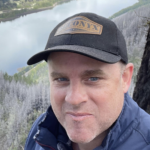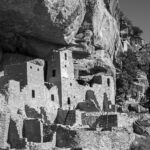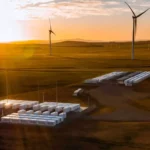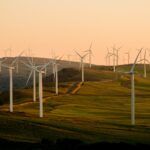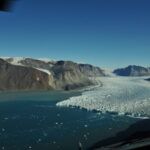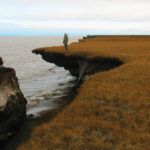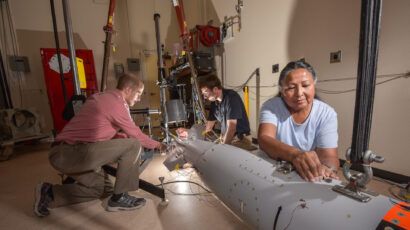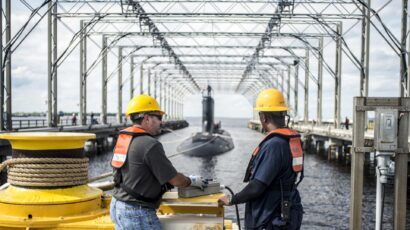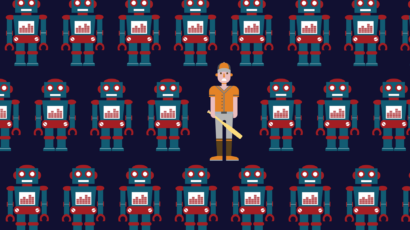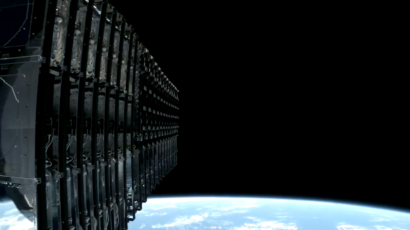Redefining the wildfire problem and scaling solutions to meet the challenge
By Beverly Law, Ralph Bloemers, Nancy Colleton, Mackenzie Allen | November 8, 2023
Redefining the wildfire problem and scaling solutions to meet the challenge
By Beverly Law, Ralph Bloemers, Nancy Colleton, Mackenzie Allen | November 8, 2023
Wildfires started by people and lightning have been part of the North American landscape since the retreat of ice sheets in the Pleistocene. As settlers colonized the American West, they viewed fire as a destructive force to be controlled and eliminated. In 1850 the US government passed legislation outlawing indigenous fire practices that had been used for thousands of years. As fire suppression ramped up, a cool, wet period from the 1940s to the 1980s gave firefighters a helping hand. These events underpinned the dominant cultural belief that the solution to wildfire is controlling it.
Today wildfire is still largely approached as a problem that can be controlled through vegetation treatments and firefighting. Yet attempts to alter vegetation before fire comes, or to suppress fire when it ignites, are not keeping communities from burning in fast-moving fires. Recent fires in Hawaii, Colorado, Oregon, and California have demonstrated the devastating effects of unpredictable, wind-driven fires.
For almost 80 years, Smokey Bear has been the face of public awareness campaigns asking people to be careful with fire, yet most fires are still caused by people—often through escaped campfires, careless use of fireworks, or energized power lines failing during wind events. The hallmarks of the most destructive fires are dry winds plus an ignition. In those fires, embers travel great distances, enter homes, and burn communities to the ground. Burning homes become the fuel to ignite other homes, unleashing mass urban conflagrations.
Earth observations from space combined with field observations reveal that climate forces are driving big fires, and these observations are helping experts identify the dominant forces and pinpoint solutions. While degraded ecosystems are more vulnerable to fire, extended drought and heat events are the main forces driving a dramatic increase in acres burned and homes lost to wildfire.
The United States is fortunate to have extensive ground-based observational data, remote sensing data, and scientific study of wildfire causes, effects, and solutions. New tools and innovations are coming online, providing better situational awareness that will allow firefighters, government at all levels, and the public to better prepare before fire comes. A better understanding of wildfire has already enabled experts to redefine the problem and highlight viable solutions for communities to survive and thrive with more fire on the land.
Those solutions include efforts to harden homes against fire, and such efforts are what insurance companies say is needed to make the risk acceptable. The tools and technology exist to make these changes, and if homes are built with wildfires in mind, the threat of wildfires destroying entire communities could be all but eliminated relatively quickly.
The devastating impacts of recent wildfires
Destructive wildfires are happening more often, burning longer and more intensely, and emerging in places not historically prone to wildfire or mapped as being at risk. The last five years have broken barriers in fire history. For example, the 2018 Camp Fire burned over 18,000 structures in and around the town of Paradise, California, and took 85 lives. The 2020 Labor Day Fires in Oregon burned over a million acres and destroyed communities identified as low risk. In 2021, the Dixie Fire became California’s largest single fire in recorded history, and the Marshall Fire destroyed more structures than any other fire in Colorado history. The western United States alone suffered a 246 percent increase in structures lost to wildfires over the decade ending in 2020.
This past summer, smoke drifting hundreds of miles from Canadian fires caused New York City to have the worst air quality in the world. And in early August, the Hawaii Firestorm was a repeat of the Paradise disaster, as wind drove fire into Lahaina and caused structure-to-structure ignition, leaving at least 97 people dead and dozens still missing. In Canada this year, over 30 million acres have burned and entire communities have been evacuated.
The impacts of wildfire events have no boundaries. Fire is inevitable, and putting out all fires is impossible. The good news is that preventing community destruction is possible, even in the most extreme conditions.
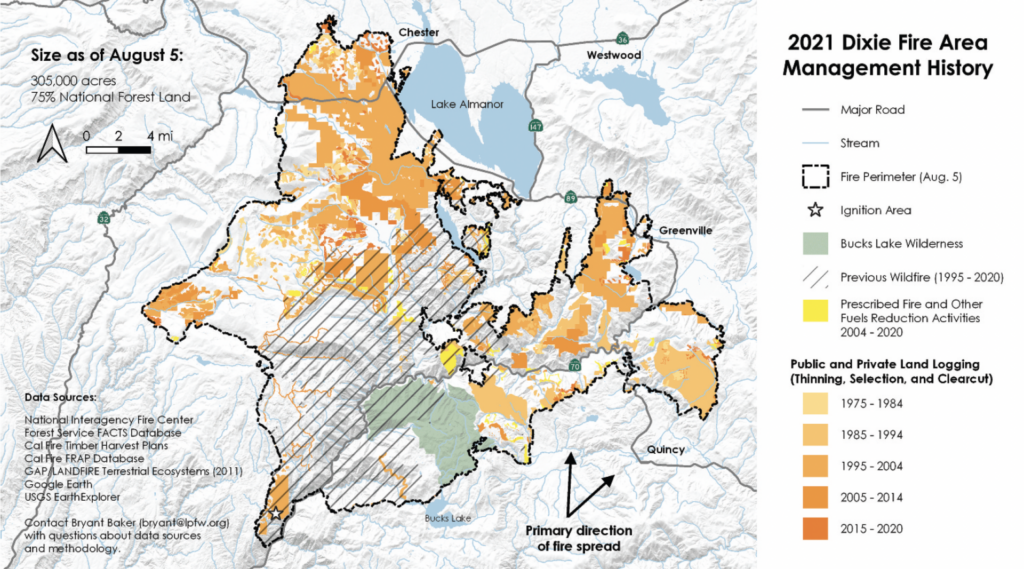
Fire history
While the annual acres burned since the 1980s have gone up considerably, creating the impression that the amount of fire on the land is unprecedented, the amount of acreage burned is a continuation of earlier fire history. A review of fire history from the early 1900s confirms that drought and wind—which are increasing in a hotter climate—play an outsize role in the amount of fire on the landscape.
The challenge today is that there are many more communities in the path of these fires. The result: a devastating increase in homes lost, lives lost, and communities destroyed.
In the last several years, more communities across the globe have experienced extreme fire behavior and rapid fire spread. The Dixie Fire, for example, skipped over treated areas, fuel breaks, and roads, and its glowing embers traveled long distances to ignite new spot fires. Strong winds drove the fire and embers into the town of Greenville, igniting homes and creating a domino effect in which flaming homes ignited other homes (Branson-Potts 2021).
These fires were stoked by drought, which reduces the moisture in dead vegetative fuel, live fuel, and soil. Lack of moisture changes the fire dynamics of fuels, leading to increased fire intensity, energy release, and ignition from wind-borne embers through spotting. Wind-driven fires have led to mass urban conflagrations, and in California most of these have occurred in grasslands and shrublands rather than forests (Schwartz and Syphard 2021). Many fires were ignited by live power lines (Gabbert 2021), and most were started by people.
Preventing home ignition
Over the past several decades, the focus in the United States has been on ramping up vegetation clearing and management as a means to mitigate and prevent extreme fires (US Forest Service 2023). Yet if one looks at devastating fires, it is clear that during periods of extreme fire behavior in high wind conditions, thinned forest plantations, prescribed burned areas, fuel breaks, dirt roads, city streets, paved multilane highways, and natural barriers such as the barren crest of the Sierra Nevada (Siegler 2021) or the Columbia River Gorge (Vance, Templeton, and Wilson 2017) did not keep fire from spotting great distances or igniting receptive fuels. All it took was an ignition leading to the burning of dry grasses and shrubs outside Superior, Colorado, to generate enough embers to ignite one home and then burn down 1,057 more homes in the Marshall Fire in eight hours.
These events are forcing communities to re-examine strategies that are not working to prevent home loss.
The US Forest Service’s Missoula Fire Sciences Laboratory, the National Fire Protection Association, the Insurance Institute for Business and Home Safety, and Underwriters Laboratory’s Fire Safety Research Institute are at the forefront of this effort. They have conducted extensive experiments that show the design and maintenance of a home and the immediate five feet around it, known as the home ignition zone, is the most critical area for preventing or reducing the chance a home will ignite (NFPA undated). Within the next 30 to 60 feet, known as defensible space, the research shows that homeowners need to reduce fuels from the home outward—for example, by not having shrubs next to the house, removing higher-risk plants like juniper and cypress, and disconnecting fences that can wick fire to a house (Cohen undated). These actions to make homes ignition-resistant should be done collectively by a community, as homes are most often the fuel that ignites and burns other homes.

Reintroducing fire to the land
Understory thinning of shrubs, saplings, and the lower limbs of large trees can help prepare the ground surface for the safe and controlled reintroduction of fire by indigenous, cultural, and prescribed-fire practitioners. This kind of understory thinning more often resembles cutting or pruning, not removal of trees, and it is generally followed by pile and broadcast burning of the ground surface where dead limbs and needles accumulate. These surface and understory fuels are decomposed by soil microbes, providing nutrients for new plants. Fire is the most effective, economical, and natural method for reducing fuels and providing nutrients for vegetation (FDACS undated).
But there are challenges. Today’s landscape is very different from the landscape that indigenous cultures stewarded. Forests are now crisscrossed with roads and power lines. Older forests have been logged and converted to young tree plantations. Many forests are lined with suburban development. Some forests have missed many cycles of fire and are not ready to handle intense fires. And the vast majority of homes that are lost to wildfires are not in forests. Still, prescribed fire and indigenous use of fire has great potential to restore and revitalize the land. By removing material from the ground, particularly fine material, land can be readied for more fire in the future.
Reaching the limits of firefighting
The changing climate has expanded the periods when fires burn. Recent “heat domes” have brought record high temperatures to the United States and Canada. These heat events further affect downed and dead fuels, vegetation, and soils. For example, the Colorado Front Range drought brought decreased late-summer rain and an absence of early winter snow, leaving cured grasses dry and flammable—conditions that enhanced the spread of the Marshall Fire (Colorado Division of Fire Prevention and Control 2021). The hard truth is that the big fires of the last several years were not “controlled” until the weather conditions changed.
Even though federal and state governments have greatly increased funding for wildfire suppression efforts, there has still been an exponential increase in homes lost to wildfires, particularly fires started by people near communities. Urban conflagrations in Santa Rosa and Paradise, California; Marshall, Colorado; Talent and Phoenix, Oregon; and Lahaina, Hawaii have exceeded the limits of firefighting capacity. New efforts must focus on preparing communities before fire comes.
Redefining the problem
Jack Cohen, a retired US Forest Service research physical scientist, says wildfire must be redefined as a building ignition problem, because defining the wildfire itself as the problem is not working or realistic (Cohen undated). Fires are inevitable, and there will always be wind-driven fires that escape control. By redefining the problem, Cohen seeks to change the focus from trying to control uncontrollable fires to taking preventive measures that protect homes and communities (Joyce 2018).
Because anthropogenic climate change is the driver of increased temperatures and drought, the most urgent and effective strategy is to invest in decreasing total carbon emissions, especially those from fossil fuels. Every other choice, including carbon offsets and misleading assumptions of carbon neutrality (Law et al. 2022), is putting a bandage on a symptom or even increasing emissions.
Widespread efforts to harden homes will also be an effective strategy for preparing communities to better face wildfires, and it is what insurance companies say is needed to make the risk acceptable (PBS 2023). The tools and technology exist to make these changes, and if homes are built with wildfires in mind, the threat of wildfires destroying entire communities could be eliminated in just a few years.
A stepwise progression
Recent fires have challenged attempts to define and limit the risk to a specific “wildland fire season” or a specific ecosystem type. There is no longer an off-season for wildfires, and they are not confined to forests. The Hawaii Firestorm, the Marshall Fire in the Front Range of Colorado, and the 2020 Almeda Fire in Talent and Phoenix, Oregon, are all part of a pattern and trend of urban mass fire disaster. A focus on forest management ignores the reality that all vegetation types can generate burning embers that ignite homes. Besides, many Western states have millions of acres of privately owned and heavily managed tree plantations that are logged on short rotations, and these plantations burn faster and hotter than naturally regenerated forests (Zald and Dunn 2018).
As to the effectiveness and likelihood that thinning forests might have an impact on fire behavior in forests, the area thinned at broad scales to reduce fuels has been found to have little relationship to area burned. At subregional to regional levels, roughly 1 percent of treatments (thinning and prescribed fires) experience wildfire each year, and the effectiveness of treatments is only 10 to 20 years, so the treatments likely have little effect on wildfire (Campbell et al. 2012, Schoennagel et al. 2017).
Furthermore, when forests are thinned through the harvesting of trees, carbon previously stored in the trees is released into the atmosphere (Law et al. 2022). Studies show that up to five times more carbon is released by thinning trees than by fire (Bartowitz et al. 2022). Mature and older trees contain the nation’s greatest carbon stores—up to half of the carbon on the landscape—and it takes generations for newly planted trees to make up for these net increases in carbon emissions.
Severe ecological disruption is expected to accelerate in the coming decades (Trisos et al. 2020). The 2040s are projected to reach 2° Celsius of warming with respect to pre-industrial levels, which will exacerbate climate impacts including heat stress and fire danger (Park et al. 2023) and reduce the habitability of some areas for large populations.
To avoid the worst consequences of climate change, the Intergovernmental Panel on Climate Change has underscored the immediate need to significantly reduce emissions and allow natural ecosystems to continue to store carbon (IPCC 2022). Permanent protection of mature and old forests is particularly important, as these forests account for a majority of terrestrial carbon stocks and accumulation (Law et al. 2022, 2021).
Natural ecosystems are the low-hanging fruit. Existing technology and Earth observations have not been tapped to their full potential. New technologies to remove carbon dioxide from the atmosphere have not been proven to keep it out of the atmosphere and are not to scale (Law et al. 2022, Foley 2023). The climate crisis requires more human intelligence, analysis, and meaningful individual, local, state, and federal action focused on solutions that are durable, scalable, and effective over space and time.
Emerging solutions
As much as people are the main cause of wildland fire ignitions, scientists, technologists, entrepreneurs, and cultural leaders are delivering solutions to meet today’s wildfire challenges. More accurate, timely, and continuous data is the centerpiece of this effort, which involves satellite observations, drones, and artificial-intelligence-generated insights, among other tools.
Coined as “FireTech,” this rapidly evolving sector dedicated solely to addressing wildfires consists of data, advanced analytics, and technologies such as robotics (Wildland Technology Funders Group 2022). In recent years, a growing number of companies and nonprofit organizations have devoted significant resources to advancing capabilities to predict, mitigate, and adapt to fire.
Satellite observations are not new, but expanded applications of government-collected space data are attempting to meet the growing needs of traditional users such as the US Forest Service, as well as newer users in the insurance and utility sectors. NASA research plays an important role in helping scientists and tech entrepreneurs better understand the environmental characteristics that are more likely to lead to fires (drought and wind), wildfire behavior, the extent and recovery of burn areas, post-fire erosion, and impacts on air and water quality (NASA undated). The agency’s science not only provides insight into the environmental changes occurring, but also helps explain why these changes are happening. The National Oceanic and Atmospheric Administration, for its part, provides real-time weather forecasting and specific fire weather forecasting capabilities along with drought, water, and wind insights (National Weather Service undated).
Because of the growing need for more accurate, timely, and comprehensive global data, commercial satellite companies such as Planet, Maxar, and Capella Space are accelerating efforts to provide data and imagery on the size, intensity, and spread of wildfires. This information helps fire managers and other entities understand fire behavior, movement, and potential threat to nearby communities, infrastructure, and ecosystems. Improved observations and science are critical to making informed decisions about evacuations, resource allocation, and firefighting strategies. Satellites equipped with thermal sensors can detect the presence of wildfires by measuring the heat signature emitted by active fires.
Increased interest in fire prediction and early detection on a global scale is also leading to new players and partnerships in the space domain. The nonprofit organization Environmental Defense Fund is partnering with Muon Space, the Gordon and Betty Moore Foundation, and others to develop a constellation of satellites devoted specifically to fire detection, prediction, and impacts (Environmental Defense Fund 2022). What has been described as a constellation of up to 50 small satellites will launch later this year with a demonstration of three satellites. The potential to provide continuous, global, and near-real-time data at critical peak fire times could significantly advance wildfire intelligence.
Capturing data from space and other sources is only one part of the equation. Applying that data and information to create wildfire intelligence is another. Perhaps one of the best-known companies working to integrate data and interpret findings is San Diego-based Technosylva, which has created a suite of products for advanced wildfire modeling that serves firefighters and the utilities sector (Technosylva undated). Technosylva’s Wildfire Analyst service produces wildfire spread-prediction and behavior models. These risk forecasts are integrated with weather-prediction systems and updated hourly, which allows for real-time operational assistance during active fires. Products like this are improving situational awareness during emergencies, allowing fire managers to understand the possible impacts of fires and improving the safety of firefighters and the public.
Dutch start-up Overstory uses artificial intelligence and machine learning to process high spatial- and temporal-resolution satellite imagery and climate data for improved vegetation management (Overstory undated). Overstory provides utilities with real-time vegetation insights, wildfire risk analysis, and recommendations to enable smarter infrastructure management. These insights help utility customers plan vegetation-management efforts near infrastructure to better mitigate wildfire and reduce the risk of power outages.
CoreLogic, an analytics company serving the real estate and insurance sectors, uses artificial intelligence and machine learning to produce its Wildfire Mitigation Score, which evaluates the potential risk of wildfire to a property (CoreLogic undated). CoreLogic is one of many companies delivering products at a property level. These products help the insurance industry, as well as homeowners, identify and understand wildfire risk and make better-informed decisions when purchasing a property. These products use geospatial analytics to analyze slope, aspect (slope orientation), vegetation, and surface composition of a property. Similar products are provided by RiskFactor.com, Verisk, Madronus, and Zesty AI.
While State Farm, Farmers, and other insurance providers have announced they are pulling out of new business in the California market because the wildfire risk is too high, entrepreneurs are stepping in with a boots-on-the-ground approach to help reduce community risk by empowering firefighters to directly assess risk to homes. Fire Aside, for example, has developed software to enable firefighters to efficiently assess how prepared a home is for fire. The homeowner is provided with a customized report that contains a prioritized list of actionable steps, access to grants, and a simple mechanism for reporting steps taken.
In one example of a community-wide approach, the Truckee Fire Protection District is doing wildfire risk assessments of every home once every three years, evaluating the homes for defensible space, vegetation management, and construction standards. The Truckee community is taking a proactive approach, with over 70 percent of homeowners taking action to create a wildfire-resilient Truckee and residents using the Fire Aside defensible space report to not only identify defensible space and home-hardening actions but also to qualify for California Department of Insurance Safer From Wildfires discounts (Fire Aside, undated).
Shifting the fire story
Scientists, researchers, and front-line firefighters are questioning the old approaches and advocating for an approach that prioritizes improving homes and communities over vegetation management in remote and uninhabited areas. In recent years, once-unusual fires have become common, and community loss has increased exponentially. People and power companies continue to ignite fires in extreme conditions, straining resources and causing incredible losses.
Despite these challenges, leaders within the fire community are embracing paradox and trying to shift the fire story to support the return of fire to the land through cultural fire, prescribed fire, and ecological fire use while simultaneously preparing communities to be ready for more smoke. Fire management and suppression are evolving to include containment within a perimeter, and a growing recognition of the benefits of letting fire do its work in maintaining natural systems. Firefighters are stepping forward to empower homeowners to prepare their homes for fire, and entrepreneurs are harnessing existing technology to provide better situational awareness and analysis before, during, and after fire comes.
Solutions to reduce wildfire impacts need to transform how people live with climate change and natural ecosystems, through changes in land use, neighborhood design, and home design to make the built environment safer. While many strategies can have an impact, given limited resources and time it is imperative to prioritize the most durable and effective solutions. For society to move from unpredictable disasters to prepared and resilient communities that can weather extreme events, policymakers, agencies, and the public will all need to accept inevitable fires and smoke and embrace a new approach to living with fire.
Together, we make the world safer.
The Bulletin elevates expert voices above the noise. But as an independent nonprofit organization, our operations depend on the support of readers like you. Help us continue to deliver quality journalism that holds leaders accountable. Your support of our work at any level is important. In return, we promise our coverage will be understandable, influential, vigilant, solution-oriented, and fair-minded. Together we can make a difference.
Keywords: adaptation, resilience, wildfire, wildfire impacts, wildfire solutions
Topics: Climate Change

